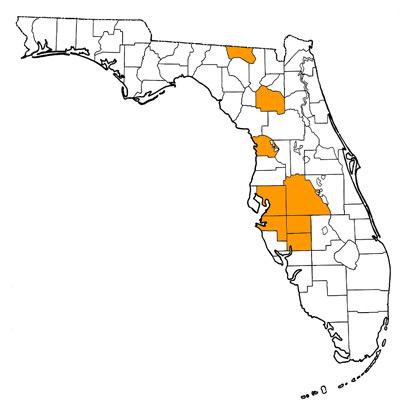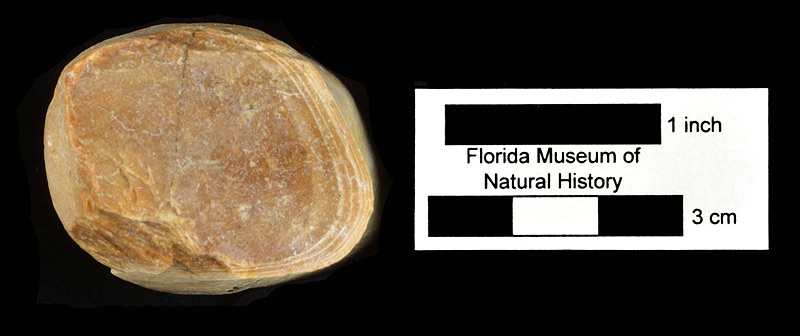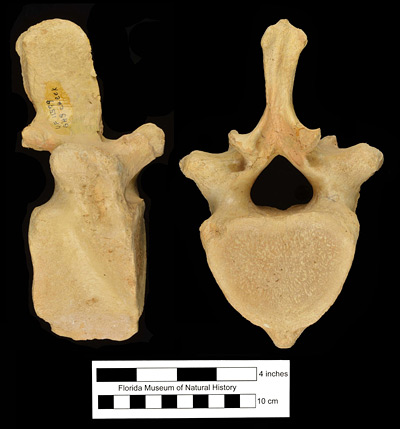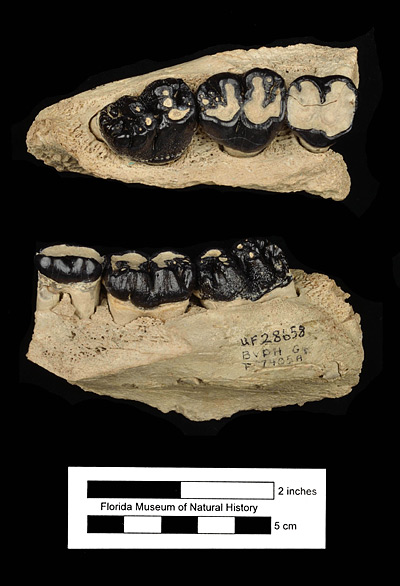Metaxytherium floridanum

Quick Facts
Common Name: Florida sea cow
Fossil dugongs are the most common mammal fossils found in Florida, and of the several known species, Metaxytherium floridanum is probably the most abundant.
Most individuals of Metaxytherium floridanum lived entirely in the ocean (salt water).
Age Range
- Middle to late Miocene Epoch; late Barstovian to early Hemphillian land mammal ages
- About 14 to 7 million years ago
Scientific Name and Classification
Metaxytherium floridanum Hay, 1922
Source of Species Name: for the state of Florida, latinized to mean “of Florida”.
Classification: Mammalia, Eutheria, Afrotheria, Paenungulata, Sirenia, Dugongidae, Halitheriinae
Alternate Scientific Names: Metaxytherium ossivallense; Felsinotherium floridanum; Felsinotherium ossivallense; Felsinotherium gunteri.
Overall Geographic Range
Metaxytherium floridanum is known only from Central and Northern Florida. The type locality is the Prairie Pebble Creek Mine near Mulberry, Polk County, Florida.
Florida Fossil Occurrences
Florida fossil sites with Metaxytherium floridanum:
- Alachua County—Gainesville Creeks Fauna [includes sites on Gainesville High School Creek, Hogtown Creek, Little Hatchet Creek, Possum Creek, Rattlesnake Creek, Tumbling Creek, and Watertower Creek (= Ames Creek)]; Love Site; McGehee Farm; Pareners Branch
- Citrus County—Lecanto 3
- De Soto County—Arcadia Creek; Peace River
- Hamilton County—Occidental Mine; Suwannee River Mine
- Hardee County—Charlie Creek 2; Fort Green Mine South; Hardee Complex Mine (CF Industries); Peace River
- Hillsborough County—Four Corners Mine East; Hopewell Mine
- Manatee County—beach at Palma Sola (Hay, 1922); Dolomite Quarry; Manatee County Dam Site; Port Manatee
- Polk County—Brewster Mine of Amalgamated Phosphate Company; Dominion Phosphate Mine; Fort Meade Mine (Mobil); Fort Meade Mine (Cargill); Grey Zone, Phosphoria Mine; Hookers Prairie Mine; Kingsford Mine; Nichols Mine (Mobil); Noralyn Mine; Palmetto Mine; Payne Creek Mine; Pool Branch Site, Peace River Mine; Peace River Mine; Prairie Pebble Creek Mine; Red Zone, Phosphoria Mine; Silver City Mine; Six Mile Creek (Unit 3); Tiger Bay Mine
Discussion
Fossil dugongs are the most common mammalian fossils found in Florida (Hulbert, 2001), and of the several known species, Metaxytherium floridanum is probably the most abundant (Domning, 1988). Its dense and massive ribs are the most typical remains, usually found in pieces ranging from 1 to 4 inches (2-10 cm) in length. They can be recognized by their rounded shape and layered structure in cross section (Fig. 2; Hulbert, 2001). After rib fragments, the most frequently found fossils are relatively dense portions of the vertebrae and the skull cap: the dorsal surface of the skull formed from the parietal and exoccipital bones. Several complete skeletons of Metaxytherium floridanum have been found, most in the phosphate mines of Polk County, but also an exquisite skeleton was found in the bank of a creek near Gainesville High School in Alachua County (Fig. 2). From these skeletons it can be estimated that Metaxytherium floridanum was about 3 to 3.5 meters long in life.

Hay (1922) named the species Metaxytherium floridanum from a partial maxilla with an upper third molar (USNM 7221) collected in a Polk County phophate mine. Domning (1988) considered it the senior synonym of Felsinotherium ossivallense which was named by Simpson (1932) from the same area. The species is characterized by a deflected rostrum probably adapted to bottom-feeding with very small and subconical tusks (Domning, 1988). Aranda et al. (1994) suggested that the species was probably a more generalized seagrass eater than contemporary dugongids that had larger, saber-like upper canines.


Fossils of Metaxytherium floridanum are very common in middle and early late Miocene strata in the phosphate mines of both northern and central Florida (Hamilton, Polk, Hardee, eastern Hillsborough counties). The other place in Florida where its fossils are common are the numerous creeks running through Gainesville (Alachua County). The youngest records of the species are from late Miocene sites in Manatee County, Florida. It is not found in the late Hemphillian (early Pliocene) deposits of the Bone Valley Formation in the central phosphate mining region; instead two different species of dugongs are present in those beds, Nanosiren graciae and Corystosiren varguezi (Domning, 1990; Domning and Aguilera, 2008).
Tooth replacement in Metaxytherium floridanum followed the same horizontal replacement pattern found in proboscidians and modern manatees, but with only a maximum of six total teeth per jaw in an animal’s lifetime. In most jaws only three teeth are present and functioning (Fig. 4); more rarely two or four. The premolars and molars of dugongids are all basically similar and cannot be used to distinguish different genera and species of similar size. Significant differences are instead found on the degree of deflection of the rostrum, the size and shape of the upper canine tusk, and the shape and thickness of the ridges on the skullcap.
There are two competing hypotheses regarding the evolutionary origin of Metaxytherium floridanum (Domning, 1988). The strong similarity between Metaxytherium floridanum and Metaxytherium medium known from the middle Miocene of Europe suggests possible cross-oceanic dispersal. Alternatively, Metaxytherium floridanum may have originated in North America from older, somewhat smaller species, such as Metaxytherium calvertense or Metaxytherium crataegensis. This hypothesis is simpler geographically, but implies parallel evolution of the rostra within the group (Domning, 1988). In a phylogenetic analysis of the Dugongidae, Domning (1994) found evidence of parallel evolution by European Pliocene Metaxytherium and North Pacific hydrodamalines. This study also supported a New World origin for Metaxytherium because its nearest sister taxa (Caribosiren, Crenatosiren) are New World in their distribution. In addition, the oldest species of Metaxytherium is Metaxytherium albifontanum from the late Oligocene of northern Florida and South Carolina (Vélez-Juarbe and Domning, 2014).
MacFadden et al. (2004) analyzed the relative proportions of stable isotopes of carbon and oxygen preserved in tooth enamel to study the diet and habitat of fossil sirenians. They found that most individuals of Metaxytherium floridanum lived entirely in the ocean (salt water), but that a few lived at least part of the time in fresh water. Carbon isotopes were compatible with a diet of marine sea grasses for most individuals of Metaxytherium floridanum, but 30% were also consuming a large proportion of some other, as yet undetermined type of vegetation.
Sources
- Original Author(s): Alexis Rojas
- Original Completion Date: October 5, 2012
- Editor(s) Name(s): Richard C. Hulbert Jr. and Natali Valdes
- Last Updated On: March 2, 2015
This material is based upon work supported by the National Science Foundation under Grant Number CSBR 1203222, Jonathan Bloch, Principal Investigator. Any opinions, findings, and conclusions or recommendations expressed in this material are those of the author(s) and do not necessarily reflect the views of the National Science Foundation.
Copyright © Florida Museum of Natural History, University of Florida